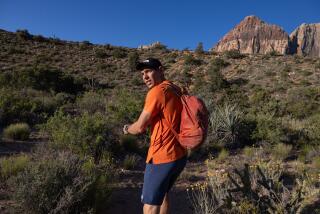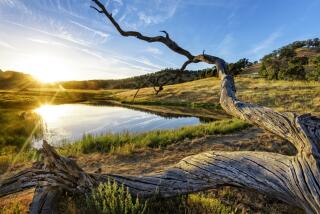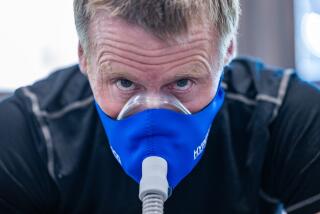No frills but big thrills at Silverton
Silverton, Colo. â There is no easy way down. Thereâs not supposed to be.
Just over the edge of my ski tips was Silverton Mountain, North Americaâs first new ski area in almost two decades and arguably one of its most thrilling. With more than 3,000 vertical feet of the steepest in-bounds slopes in the country, neck-deep powder and wide-open bowls, it has what expert skiers and snowboarders dream of.
For $99 a day you get nearly unfettered access to this 1,600-acre ski mountain in southwest Colorado. Because the number of skiers is limited to 40 a day, you donât have to fight crowds. Groomed runs donât exist here -- Silverton doesnât even have a grooming machine -- and the resort has only one two-person lift, bought from Californiaâs Mammoth Mountain.
Itâs the type of steep and deep skiing I live for. Iâm a certifiable powder hound who spends 30 to 40 days a year on skis, but even I was a little nervous.
I was also excited about being one of the first to ride the lift to the top of this mountain six miles from town. Iâd been following the development of Silverton for years and made a reservation as soon as I heard the lift was ready to roll.
Steve DeClute, of Timnath, Colo., my college roommate a lifetime ago and a top-notch skier, joined me last February on a trip here.
I drove eight hours from Denver and slept at a roadside motel about an hour north of town, making the final predawn push to this town 50 or so miles north of Durango.
Now we were here, and I was psyched. The sky was clear and blue, the wind was howling and frost nipped at my cheeks and nose. Before proprietor Aaron Brill and I ascended Silverton Mountain, he made sure the avalanche beacon I was wearing worked properly. The Bureau of Land Management worries about that danger on this mountain -- there are dozens of major avalanche areas at Silverton -- and has restricted Brill to 40 guided ski tours each day as a precaution. Besides the beacon, each of us was required to carry a shovel and an avalanche probe.
Apprehension and excitement mingled in my head the split-second before I pushed myself forward, letting the pull of gravity catch me and the rhythm take over.
The nervousness lessened with each arc I carved on terrain that was steeper and more challenging than most black-diamond runs at traditional ski resorts.
By the time I reached the bottom, about an hour after Iâd ascended, my thighs were burning, my chest was heaving and I was euphoric.
For the best and bravest
Brillâs little slice of powdery paradise holds its own against the Westâs best ski resorts, many of which Iâve tackled. Hereâs how Silverton stacks up:
More than 400 inches of snow fall here each year, giving Silverton a ski season that lasts from October until July.
The mountain boasted more than 100 inches of snow when it opened last month. By contrast, Lake Tahoeâs Heavenly Valley gets an average of 360 inches each year and is usually open only until May.
Silvertonâs base elevation is 10,400 feet. The top of Mammoth Mountain -- to my mind the pinnacle of California skiing -- in the Eastern Sierra is 11,053 feet.
The steepest double-black diamond runs at most ski resorts are 25 to 30 degrees. That is the easiest pitch at Silverton, where the steepest runs approach a downright scary 55 degrees.
With terrain like that, Silverton is not a place for beginners or even intermediates. If you brag to friends and family about skiing a black diamond, you probably arenât ready for Silverton.
This mountain is made for people who spend their days at other resorts looking for hidden stashes of powder and gnarly terrain untouched by crowds. And itâs for the people who occasionally duck beneath a rope to frolic in the forbidden treasures just off the main run.
If the thought of this kind of skiing makes you want to quit your job and leave your lover, Silverton Mountain is for you.
âEssentially, the advanced and expert skier is underserved,â says Brill, a thirtysomething snowboarder with wavy red hair who is laid-back in the kind of way that has California all over it. (Itâs Berkeley in his case.)
Brill has ski-bummed his way throughout the West, hitting California, Montana, Utah and points in between. He came up with the vision for Silverton Mountain while visiting New Zealand, where he saw mom-and-pop ski areas that offered access to challenging terrain.
After studying ski area management at Colorado Mountain College in Steamboat Springs, he settled on Silverton. More than two years ago he began buying up old mining claims on what is now his mountain.
Using grants and low-interest government loans, Brill built his ski mountain for about $200,000 -- $78,000 less than the median home price in October for Los Angeles County.
âThis is about having a place where advanced skiers and riders can go and not bang elbows with somebody,â he said. âWe have extreme terrain that nobody else has.â
With a terrain that is prone to avalanches, Brill has a full-time ski patrol that monitors snow and weather. They can drop explosives to trigger controlled slides, among other precautions. Even so, everyone who rides Silverton must carry the beacon, probe and shovel.
âIâm not trying to intimidate anyone, but this is a serious ski area,â Jenny Ader, Brillâs business partner, told us at the beginning of our day. The threat of an avalanche is very real, and Ader tells skiers to âfight ... swim, kick off your skis, whatever you have to doâ if you get caught in a slide.
The simple life in Silverton
You may spend the day riding wide-open bowls above the timberline or snaking through tight, tree-lined gullies. Your guide chooses the runs based on his or her knowledge of the mountain and the skiersâ abilities.
When I skied Silverton, Brill guided me and five others. The double chairlift spat us out at 12,300 feet. Ordinarily you can climb to 13,300, which means 3,000 vertical feet staring you dead in the eye, but we did not because of the avalanche danger.
We didnât miss out on much. A few days before I arrived, the wind had shifted, blowing snow into new areas. Our group made runs through the trees, following Brill to pockets of powder. No need to worry about those going first stealing fresh tracks. There are plenty of lines for everybody.
But the mountain is unforgiving, and if you get sloppy, youâre sure to take a tumble.
âThe skiing is classic Colorado backcountry terrain ... long, steep and kind of sketchy in some places,â said Lance McDonald, 39, of Telluride who skied the mountain last winter. âItâs great to see a ski area thatâs all about skiing and riding, and not about shopping or spa-ing.â
Glitzy itâs not.
A large canvas tent serves as the base lodge. You must bring your own lunch. (I ate salami and cheese sitting on the tailgate of a pickup truck in the tiny parking lot.)
Silverton, a down-on-its-luck mining town, has only 500 year-round residents and draws few visitors in winter because of its remoteness and weather. Most of Silvertonâs tourist-related activity comes during the summer, when the narrow-gauge train from Durango deposits a load of visitors in town for a couple of hours each day.
To call the lodging, dining and après-ski opportunities limited is an overstatement. Five bed-and-breakfasts and eight motels are among your few lodging options. Only seven of Silvertonâs 19 restaurants are open during the winter.
If you donât expect much from your non-skiing time in Silverton, the experience can be refreshing, free of the boozy hot-tub culture that permeates so many other resorts.
The town is disarming, with 100-year-old restored Victorians standing next to dark and dilapidated minersâ cabins. You wonât find a Starbucks, but at the Avalanche coffeehouse the ownerâs dog, a heeler named Abby, will greet you with a lazy gaze. You may not be able to order a bottle of your favorite Bordeaux with dinner, wine lists being somewhat limited here, but a burger and a beer will cost you less than $10.
This ski season does promise some improvements in town and on the mountain. Ski and snowboard rentals will be offered this year, with a focus on wide skis. Brill also will sell beer and wine to thirsty skiers now that he has a liquor license.
I left a beer in the car to break open for a post-ski celebration. After my last run, I popped it open and raised a toast to the best skiing day of my life.
Kyle Henley, of Denver, is a reporter for the Gazette in Colorado Springs, Colo.
More to Read
Sign up for The Wild
Weâll help you find the best places to hike, bike and run, as well as the perfect silent spots for meditation and yoga.
You may occasionally receive promotional content from the Los Angeles Times.






